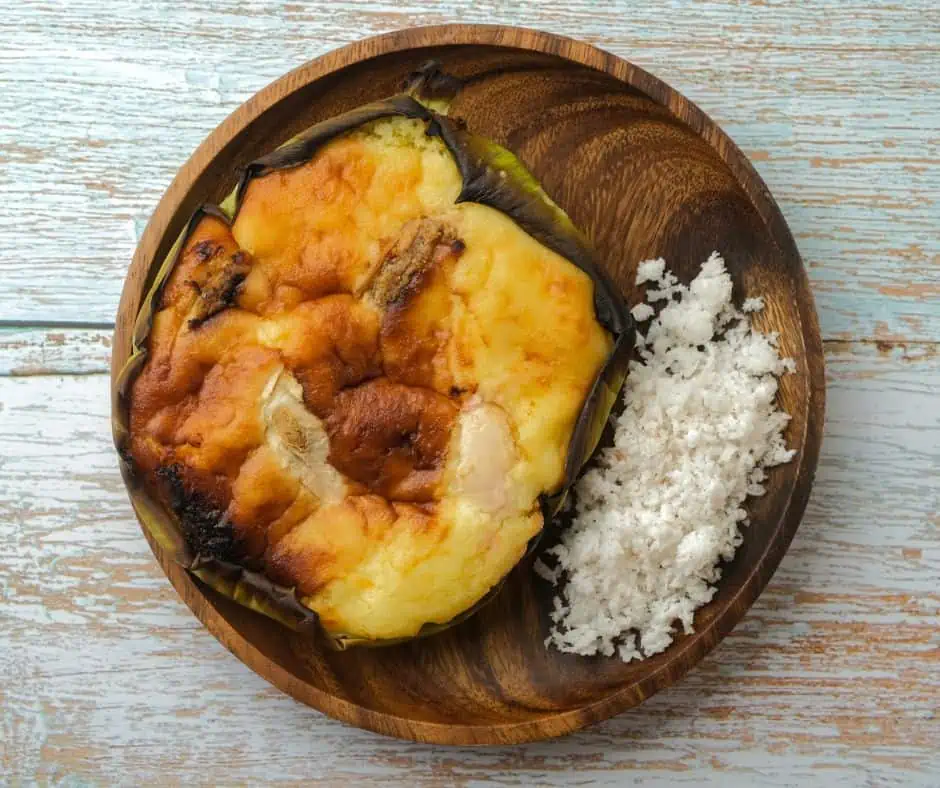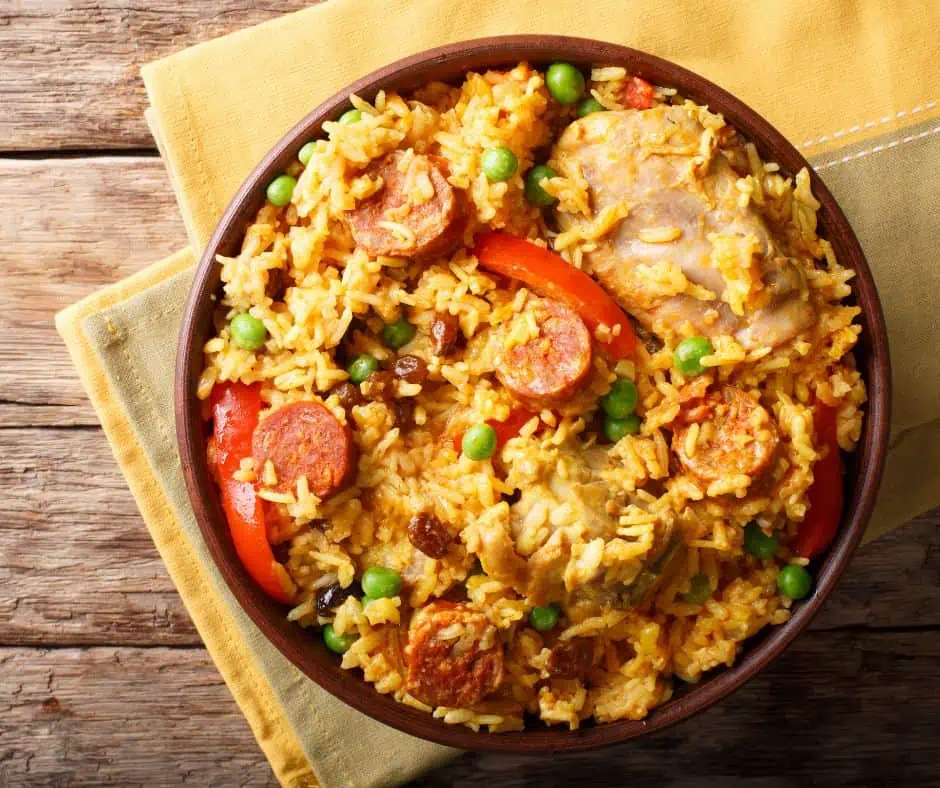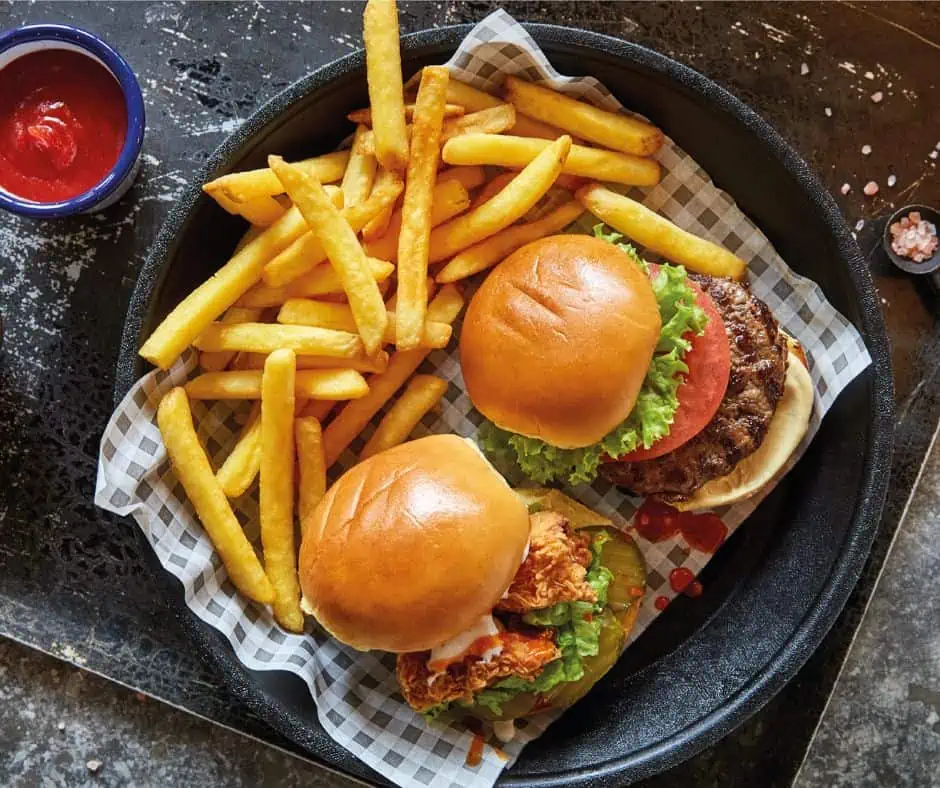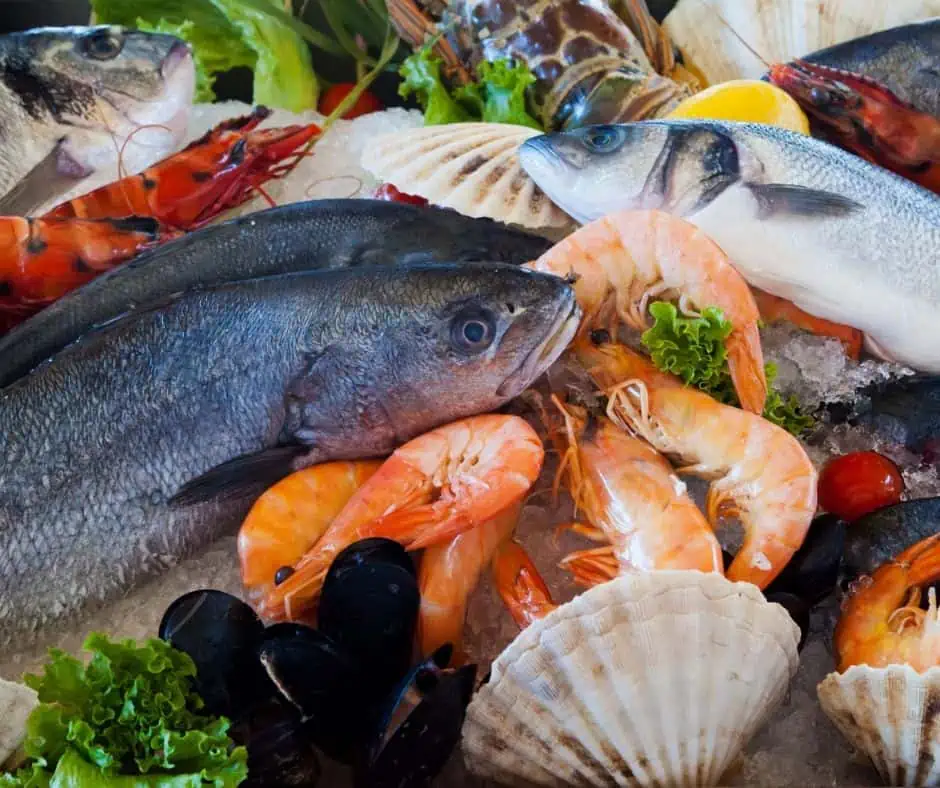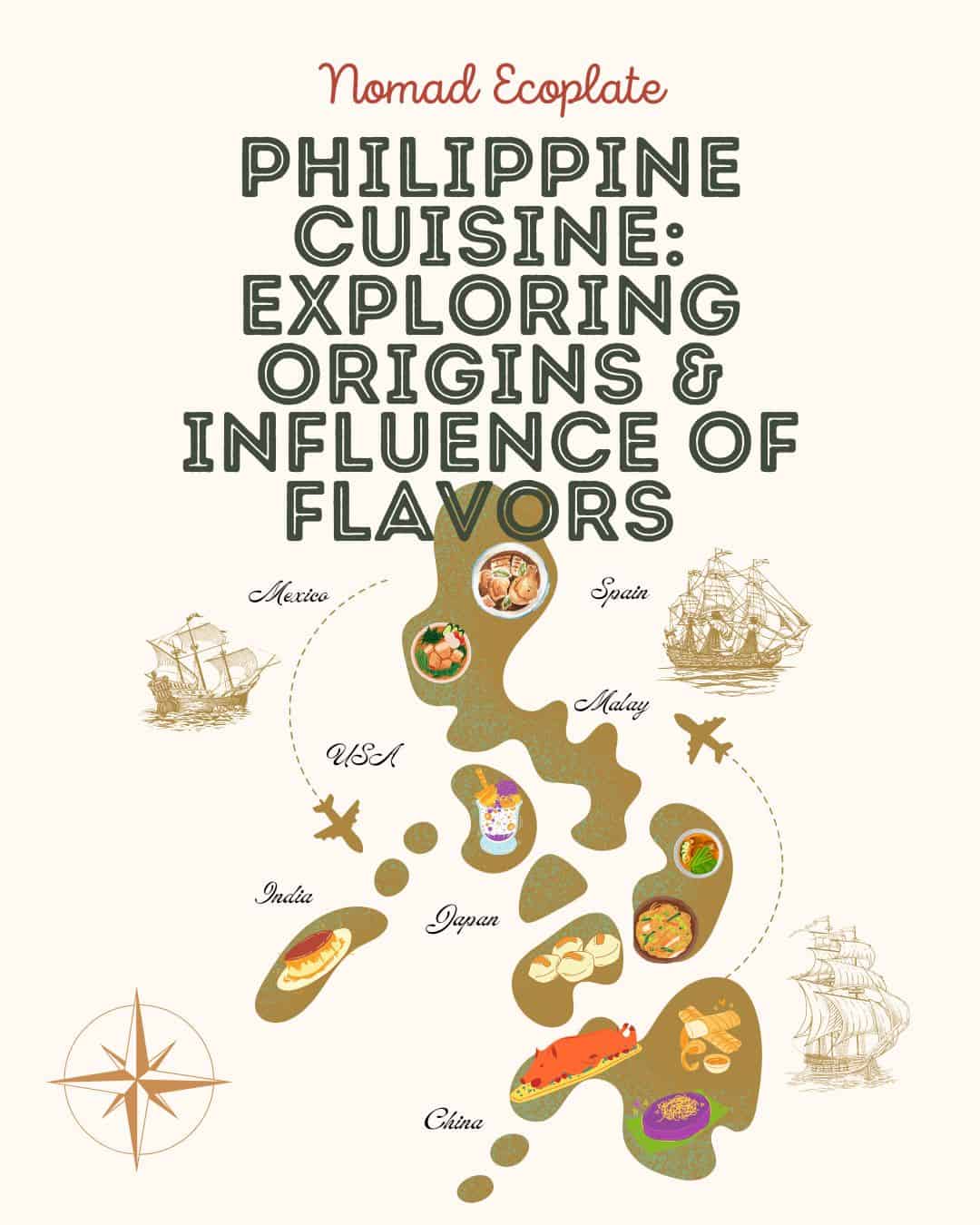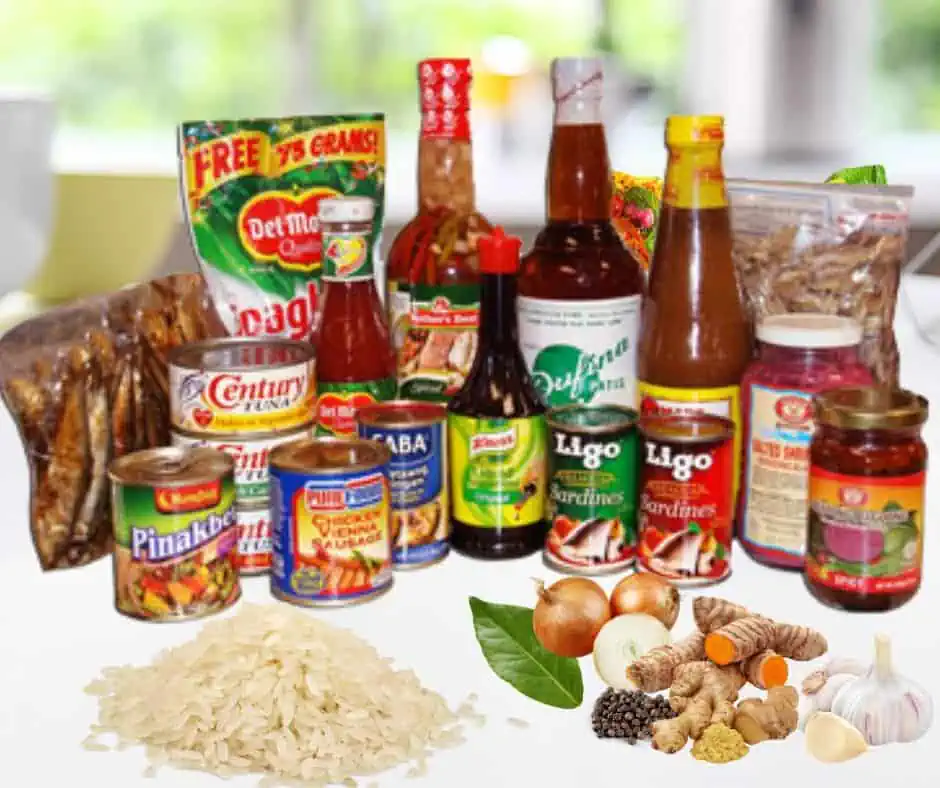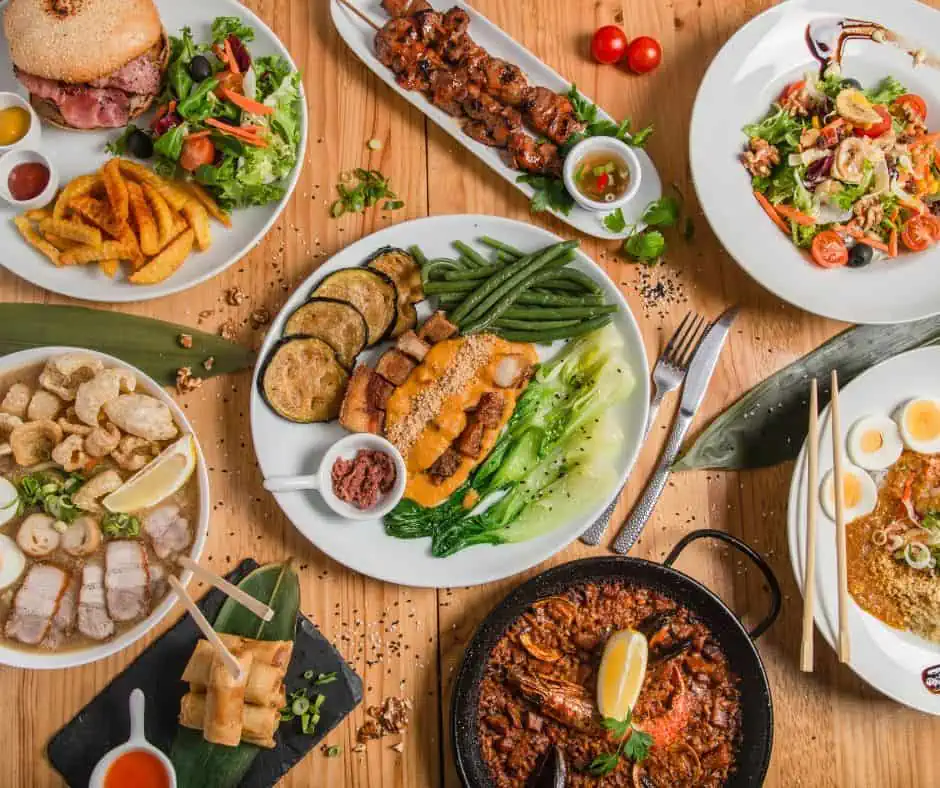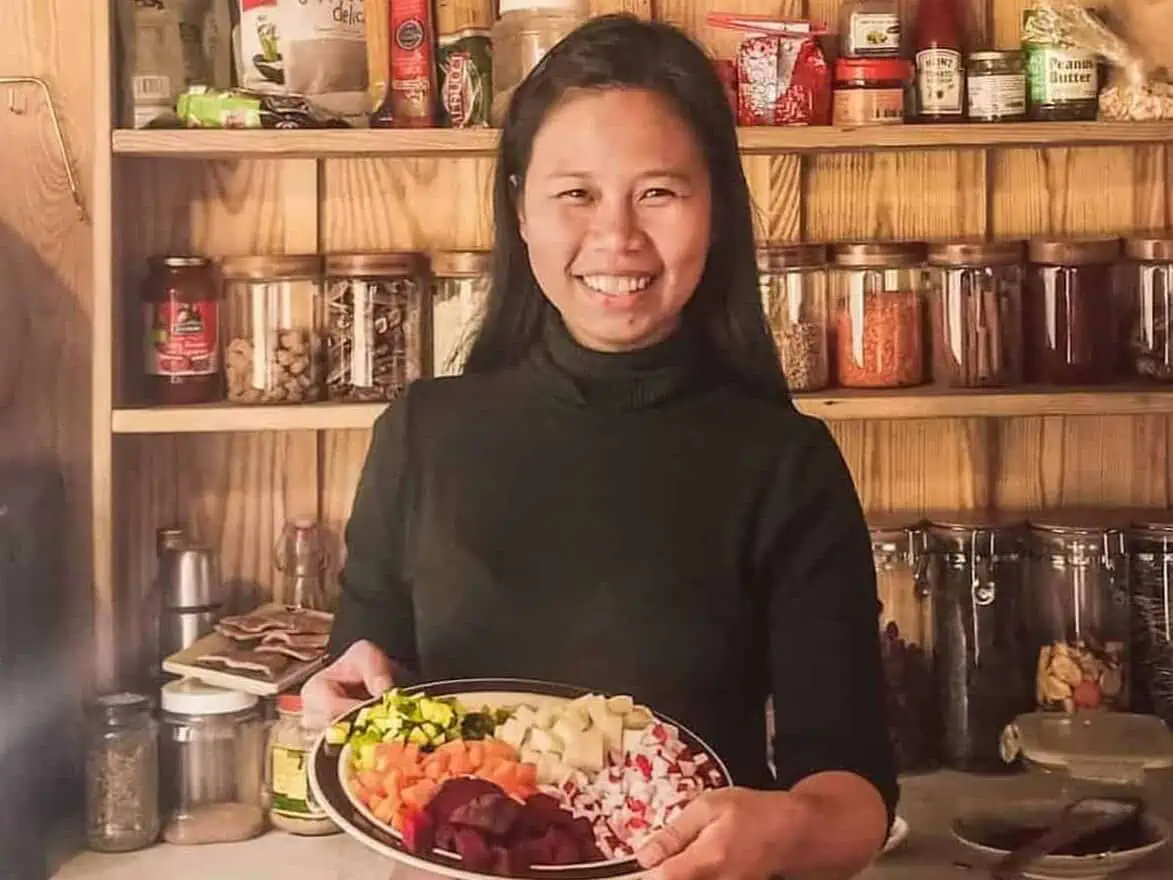As a Filipino traveler, I have frequently been approached by foreigners who express curiosity about the cuisine of the Philippines and wonder why it remains relatively underrated compared to other Southeast Asian countries. The answer to this question lies in our complex history. Having endured 425 years of colonization by various invaders, our culinary landscape has been shaped by a unique blend of influences. This fusion of flavors and cultural exchanges sets Philippine cuisine apart and contributes to its distinctiveness.
Through my blog on Philippine cuisine’s origin and influence, I aim to shed light on the rich tapestry of flavors that define our culinary heritage. By exploring the historical context and the fusion of indigenous, Spanish, Chinese, and American influences, I hope to provide a deeper understanding of why Filipino cuisine is often overlooked and underrated.
It is my belief that by sharing the stories behind our dishes and highlighting the resilience and creativity of the Filipino people, we can bring greater recognition and appreciation to the diverse and vibrant flavors that make up our culinary identity.
Philippine cuisine is all about embracing the amazing ingredients found in the archipelago. Think tropical fruits, fresh seafood, and delicious veggies. The local peeps know how to rock it in the kitchen!
Brief overview of Philippine cuisine history
Filipino cuisine is a beautiful blend of indigenous flavors rooted in pre-colonial times to the Spanish, Chinese, Malay, Indian, Japanese, and American influences. Filipino food is a delightful fusion of traditions.
Traditional Filipino dishes showcase a blend of sweet, sour, salty and savory flavors, with a touch of tropical flair. From the famous Adobo, a mix of tender meat, soy sauce, vinegar, and spices, to Sinigang, a comforting soup bursting with tangy tamarind goodness, each dish tells a unique story.
One cannot discuss Filipino food without mentioning the love affair with rice. Rice is the staple food in the Philippines and serves as the foundation for many traditional dishes. Whether it’s paired with barbecued meats or lovingly wrapped in a banana leaf to create the iconic dish known as “suman,” rice is a central part of Filipino culinary culture.
Filipino cuisine also reflects the country’s geographical diversity, with regional specialties showcasing the abundance of seafood, tropical fruits, and aromatic herbs. Whether you’re indulging in the fresh seafood delicacies of the coastal regions or savoring the hearty flavors of dishes from the mountainous provinces, Filipino food never fails to captivate the taste buds.
Beyond its delectable dishes, Filipino culinary traditions are deeply rooted in community and hospitality. Eating together, sharing food, and celebrating life’s moments with loved ones are integral parts of the Filipino dining experience.
Fast forward to the present day, Filipino cuisine continues to evolve and innovate. Talented Filipino chefs are putting their own creative twists on classic dishes, elevating them to new heights and gaining international recognition.
The ancient Filipino diet[1], as revealed through archaeological research, offers a fascinating window into our culinary past. By studying human remains from burial sites spanning thousands of years, we’ve discovered a diverse range of food sources. Despite the introduction of rice cultivation, ancient Filipinos maintained a reliance on plants and domesticated animals for protein.
In specific areas like Cebu, Batanes, and the Cagayan Valley, unique dietary patterns emerged. In Cebu, corn thrived due to the favorable soil conditions, while Batanes relied on salted and dried arayu fish, a tradition passed down through generations. Excavations in the Cagayan Valley unveiled a surprising revelation: collected shells were not directly consumed but instead used to make preserved oyster meat, possibly traded with other communities.
Understanding our ancient Filipino diet allows us to celebrate our cultural heritage and appreciate the resourcefulness and adaptability of our ancestors. It’s a testament to their knowledge of local ecosystems and their culinary craftsmanship.
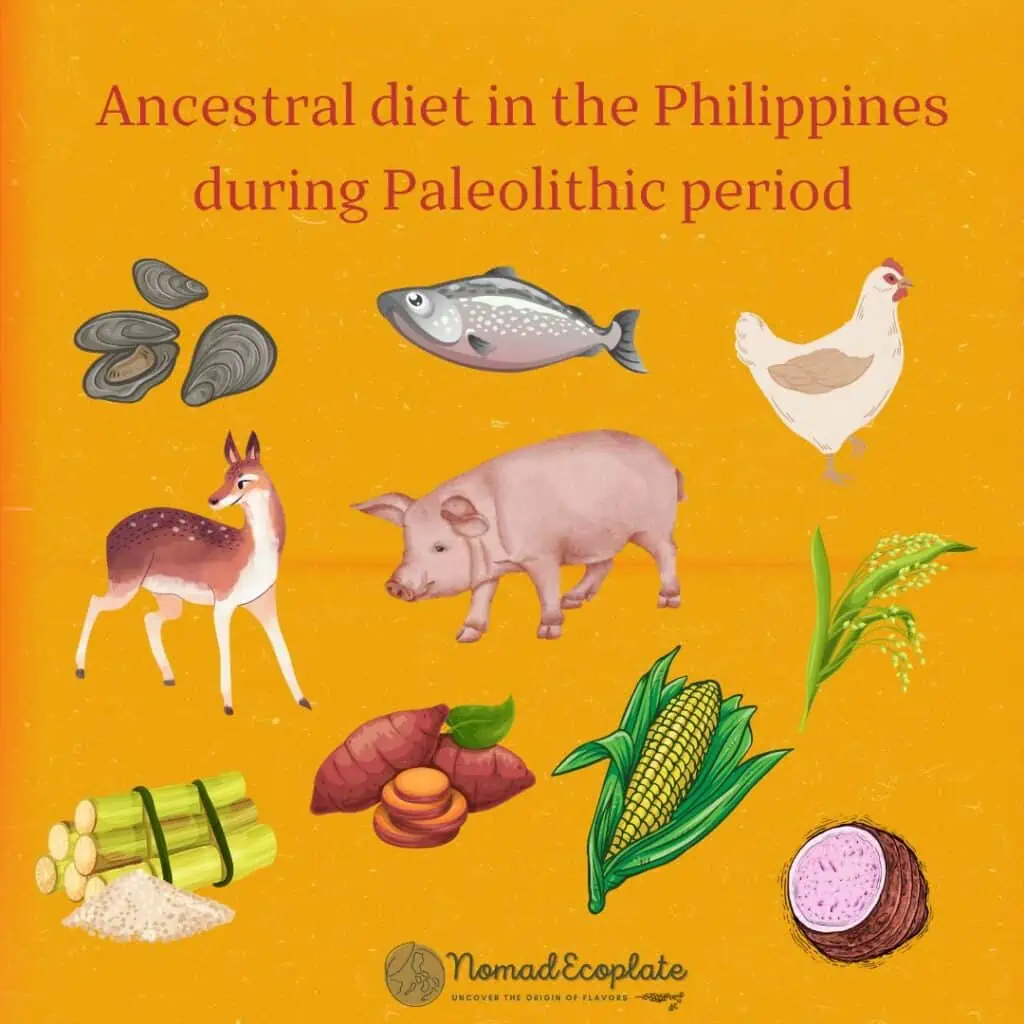
Indigenous Cooking method: boiling, grilling, and roasting over an open flame.
Foods: Terrestrial animals like deer, pigs, and chickens were consumed, along with shellfish, fish, and various plants like taro, yam, sugar cane, millet, rice, potato, and corn.
The Malayo-Polynesian influence on Filipino cuisine can be traced back to the Austronesian migration and extensive trade networks. This influence has greatly shaped the flavors and ingredients found in Filipino dishes.
The Malays, the first inhabitants of the Philippine Islands, left a lasting mark on Filipino cuisine. Their culinary influence can be seen in popular dishes like Pinakbet, a flavorful meat and vegetable stew seasoned with shrimp paste, and Dinuguan, a unique stew made from pork meat and blood, spiced with chili peppers.
The influence of the Malayo-Polynesians can be seen in the diverse range of Filipino dishes that incorporate rice, seafood, spices, and coconuts. It has contributed to the unique flavor profiles and cooking techniques that define Filipino cuisine today.
While Filipinos generally prefer milder flavors compared to their Southeast Asian neighbors, dishes from the Bicol region stand out for their use of chili and coconut milk, reminiscent of Indonesian, Malay, and Thai cuisine. It is called Bicol Express, a fiery dish, features pork strips sautéed with garlic, onions, ginger, and turmeric, combined with bagoong alamang (salted and fermented shrimp sauce), coconut cream, and a medley of hot green and red peppers.
Muslim cuisine in Mindanao, with its origins in Malaysia, retains its distinct flavors in the Philippines. Spicy and aromatic, it incorporates ingredients such as coconut milk, chilies, cassava, and rice.
Many delightful Philippine desserts, particularly those made with rice and coconut, bear a striking resemblance to Indonesian and Malaysian sweets. Biko and suman, sticky rice cooked with coconut milk and sugar and wrapped in banana or pandan leaves, bibingka and puto, different varieties of rice cakes, and bukayo, a satisfying crunchy sweet made from grated coconut cooked in molasses and shaped into bars, are just a few examples.
The influence of Malay-Polynesian cuisine is also evident in dishes like Inasal (grilled chicken), Ginataang manok (chicken in coconut milk), Ukoy (shrimp fritters).
The influence of the Malays remains prominent in the culturally conservative areas of Mindanao, southern Palawan, the Sulu Archipelago, and to some extent in rural parts of the Visayas and Luzon. These regions have witnessed significant Malay involvement and intermixing since the classical era, which has contributed to the preservation of Malay food, traditions and customs.
Chinese culinary influence on Filipino cuisine is undeniable. Chinese traders brought noodles, soy sauce, spices, and livestock like ducks and pigs to the Philippines. Over time, Chinese merchants intermarried with Filipinos and popularized Chinese food and ingredients, becoming bakers, storekeepers, and restaurant owners.
The Chinese introduced pancit (noodles) and lumpia (vegetable rolls), while dishes like arroz caldo (rice porridge) and goto (tripe porridge) have their roots in Chinese congee. Fujianese influences, known for their reliance on pork, added another layer of flavor.
Pancit, with its various forms, represents the wide range of noodle dishes enjoyed by Filipinos. Mung beans, brought by the Chinese, are now commonly used in sweet fillings for treats like hopia.
The Chinese influence on Filipino cuisine dates back to ancient times when traders sailed across the South China Sea, establishing trading routes and colonies. The influence of Cantonese cuisine is more recognizable with its stir-fried noodles and recognizable dishes, the influence of Fujianese cuisine is subtler. Fujianese cooking, rooted in poverty and limited resources, heavily relies on pork and pork lard due to the region’s lack of land for vegetable oil production. This culinary fusion is evident in dishes like pancit, siopao, siomai, pancit molo, and lumpia.
The centuries-old connection between Chinese and Filipino culinary traditions has shaped the vibrant diversity of our cuisine.
[Source: Fernandez, D. (1994). Tikim: Essays on Philippine food and culture.]
When the Spanish arrived in 1521, they brought with them a taste of Spain that would forever shape Filipino cuisine. Spanish food products like ham and chorizo made their way to Filipino tables, while cooking techniques such as sautéing, stewing, and baking became prominent in local kitchens.
The Spanish influence is evident in beloved Filipino dishes like adobo, a tangy and savory stew made with vinegar, soy sauce, and meat. Another culinary gem is caldereta, a rich and hearty meat stew that satisfies with every spoonful.
Spanish dishes like morcons (filled rolled meats), rellenos (stuffed dishes), and afritada (dishes fried and simmered in tomato sauce) are now considered fiesta fare, reserved for special occasions due to their expensive ingredients. The fusion of Spanish and Filipino culinary traditions, coupled with the absence of religious food taboos, has made pork an indispensable ingredient in the Filipino diet.
The Spanish culinary legacy in the Philippines is a Mediterranean melting pot. Influences from Arabs and Sephardic Jews can be seen in the crops they introduced, such as sugar, saffron, rice, citrus fruits, and vegetables like eggplant and spinach.
Filipinos developed a taste for olive oil, tomatoes, eggplant, garbanzos, sweet red peppers, paprika, and saffron—clear signs of Spanish influence. Rellenos encompass a variety of stuffed delights, from poultry and seafood to vegetables. Afritada refers to tomato-based dishes that are first fried and then simmered in tomato sauce. Morcon and embutido are examples of stuffed rolled meats simmered in tomato sauce, while chorizos and hams add robust flavors to soups, stews, and stuffing.
Stews like cocido and puchero, rice-meat dishes, and elaborate desserts like brazos and tortas imperiales are often associated with festive occasions and the dining tables of the upper classes.
Approximately 80% of the dishes prepared in Filipino kitchens today have Spanish roots. The Spaniards introduced tomatoes and garlic, along with the technique of sautéing them with onions in olive oil. This influence can be seen in popular baked goods and desserts like Pan de Sal (a crusty dinner roll), Flan (an egg custard), and Ensaymada (cheese buns), as well as rice dishes like Arroz Valenciana and Arroz Con Pollo. Filipino adaptations of Spanish recipes emerged, incorporating locally available ingredients and giving rise to a cuisine uniquely Filipino.
From adobo and caldereta to paella and leche flan, Spanish influence is deeply ingrained in Filipino culinary traditions.
Beyond the festive Spanish dishes that grace Filipino tables, the culinary landscape of the Philippines bears a significant mark from the vibrant flavors of Mexico. The galleon trade, which flourished between Manila and Acapulco from 1565 to 1815, fostered an exchange of people, goods, and, most importantly, food.
As a distant colony, the Philippines relied on the government bureaucracy in Mexico for governance, leading to a profound Mexican influence on the islands’ culinary heritage. Tagalog, the basis of the national language Pilipino, adopted numerous words of Nahuatl (Aztec) origin, including nanay (mother), tatay (father), tamales, calabaza, camote (sweet potato), sili (chile), chocolate, singkamas (jicama), tiangui or tiyangge (market), and tocayo (namesake).
Numerous beloved Filipino dishes trace their origins to Mexico. Adobado, marinated in vinegar and spices; asado, infused with vinegar and tomatoes; and estofado, enriched with sugar and vinegar, all arrived in the Philippines through Mexican influence. The delicate empanadas, irresistible turnovers enjoyed during merienda, also found their way into Filipino hearts via Mexico.
Mexico introduced Filipinos to the use of bay leaves and annatto seeds (atsuete or achote), which can be found as evidence of this influence in Filipino favorites like Adobo, a braised pork or chicken dish simmered in vinegar and salt or soy sauce, and Menudo, a hearty pork and liver stew.
The fusion of Mexican and Filipino flavors has added depth and richness to the vibrant tapestry of Filipino cuisine.

Foods: Mexico contributed a plethora of fruits, vegetables, and root crops to the Philippines, including tomatoes (kamatis), potatoes (patatas), cassava (kamoteng kahoy), corn (mais), peanuts (mani), bell peppers (siling pula), chilis, pineapple (pinya), papaya, guava (bayabas), star apple (kaymito), avocado, jicama (singkamas), chayote (sayote), cacao(kakaw), soursop (guyabano), chico, lima beans (patani), string beans (sitaw) bay leaf (laurel) and annatto seeds (atsuete).
In return, the Philippines sent mangoes, tamarind, rice, and tuba (coconut toddy or wine) to Mexico, establishing a delightful culinary exchange.
One such chapter in the culinary history of the Philippines unfolds during the British occupation from 1762-1764.
During this period, the British, accompanied by 500 sepoy troops from Madras, India, seized control of Manila, the capital of the Philippines. However, a fascinating twist awaited them. The Sepoys, army privates hailing from Madras, found themselves reluctant to return to England. Instead, they chose to make the Philippines their home, settling east of Manila in Cainta, Rizal. Over time, they assimilated with the locals and formed lasting connections through intermarriage.
With the Sepoys’ presence, the exchange of culinary traditions and ingredients began to unfold. Indian spices and flavors found their way into Filipino kitchens, leading to intriguing culinary transformations. Two key ingredients that reflect this fusion are annatto and coconut milk.
Annatto replaced turmeric, infusing a vibrant yellow-orange hue into Filipino recipes. Coconut milk took the place of yogurt, lending a creamy richness to various dishes.
One prominent example of Indian influence is kare-kare, a Filipino stew. Inspired by Madrasi curry, kare-kare features a peanut-based sauce and derives its name from the Tamil word “Kari.” Even the term “Karinderya,” referring to roadside stalls, has Indian roots, stemming from “Karihan.”
The arrival of American food in the Philippines had a big impact on Filipino cuisine, shaping the way people eat even today. Burgers, hot dogs, pizza, soda, and fries became popular, especially among the post-war generation, and these American influences continue to spread across the country.
American canned goods like Spam, Vienna sausage, fruit cocktail, and evaporated milk became staples in Filipino households by the 1950s. Chiffon cake also became a beloved dessert, reflecting American culinary traditions.
The American government introduced Filipinos to dairy products, canned meats, vegetables, and fruits in an effort to improve nutrition. The Philippine government supported these dietary changes and even organized cooking classes in schools to teach American recipes. However, while some attempts were made to incorporate local ingredients, many recipes lacked the nutritional value we prioritize today.
American food and culture became a part of Filipino society at all levels. Canned products like Spam, corned beef, and fruit cocktail became cherished comfort foods, sometimes overshadowing fresh local produce. The introduction of technology like microwaves and refrigerators also transformed cooking and storage practices.
Fast food culture took hold in the Philippines with the rise of Jollibee, a homegrown hamburger chain comparable to McDonald’s. Convenience became important, with pressure-cooking, freezing, pre-cooking, and the popularity of sandwiches, salads, fried chicken, and steaks. Is it healthy? heck no!
Additionally, another significant development in Filipino cuisine is the boodle fight, a communal way of dining that originated from the military. This tradition involves a spread of food laid out on banana leaves, where everyone eats with their hands, creating a sense of camaraderie and togetherness.
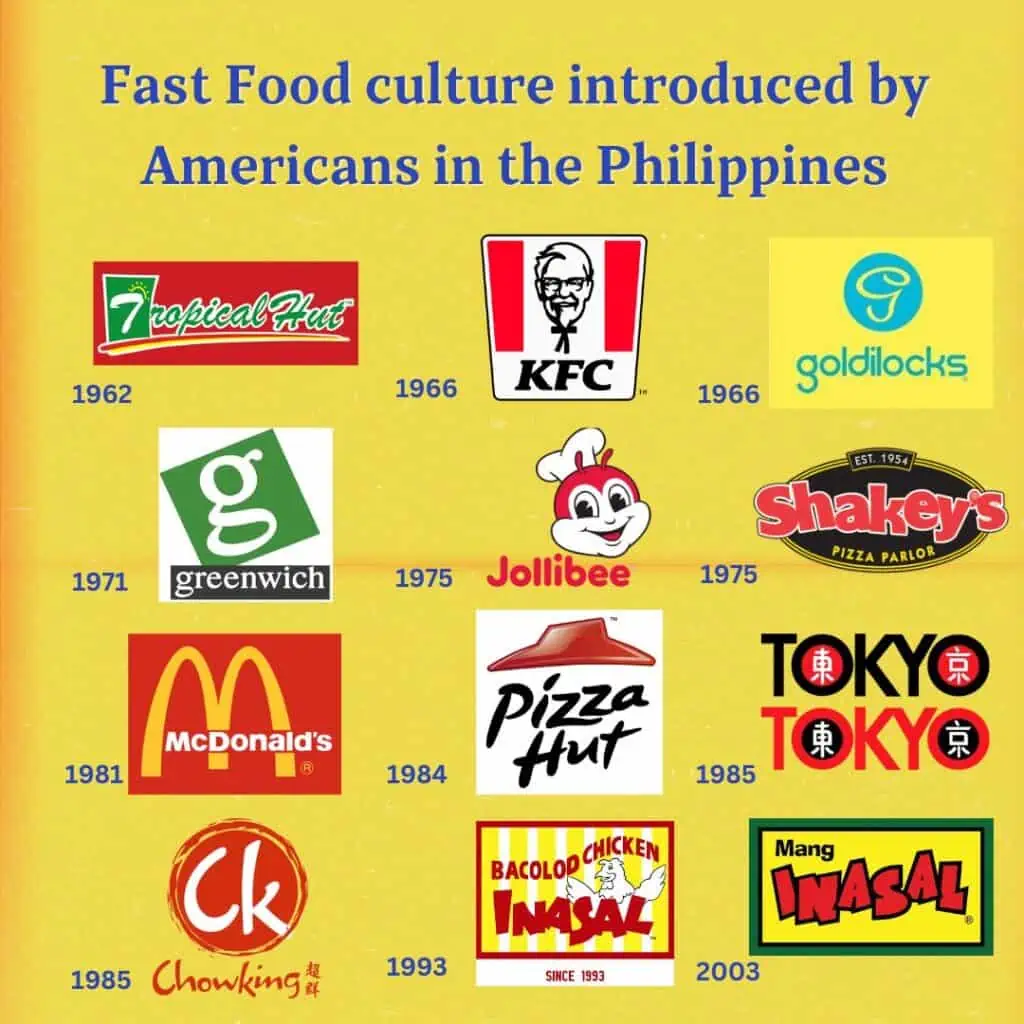
Speaking of Fast food culture, here are some famous fast food chains that most Filipinos grew up eating. These establishments have become a significant part of Filipino dining and hold a special place in the hearts of many.
The Japanese influence during World War II has played a significant role in shaping Filipino gastronomy. One delightful example is the popular Filipino dessert called halo-halo, which draws inspiration from the Japanese shaved ice dessert kakigori. Halo-halo features finely shaved ice topped with red bean preserves and other delightful ingredients, showcasing the fusion of Japanese and Filipino flavors.
“The origins of Halo-Halo”
It all started with a simple treat called “mongo con hielo” sold in soda shops owned by Japanese people in Naga, Camarines Sur. Mongo con hielo was made of boiled mung beans, milk, sugar, and shaved ice. But things took a dark turn during World War II.
Before the Japanese invasion of the Philippines, there were quite a few Japanese residents in Camarines Sur, particularly in Naga. Some of them owned retail stores, like the Filipino Bazar and the K Mori refreshment parlor, where they served mongo con hielo. Little did the residents and Bicolano customers know, these Japanese merchants had a secret mission.
When the Japanese Army arrived in Naga, it came as a surprise to the residents that many of these merchants were actually high-ranking officers in the Japanese Imperial Army. They had been hiding their true identities all along. This unexpected revelation turned those innocent soda shops into something much more sinister.
And that’s how the humble mongo con hielo eventually evolved into the popular Filipino dessert we know today as Halo-Halo.[3]
Japanese migrant workers introduced udon or odong noodles to the Philippines, which have since found their way into Filipino dishes such as haob na odong, a unique twist on lasagna made with udon noodles. Another testament to the Japanese influence is the incorporation of miso, a traditional soybean paste, in Filipino cuisine. Sinigang sa miso, a Filipino soup, combines the tangy flavors of sinigang with the distinct umami notes of miso, creating a harmonious blend of Japanese and Filipino culinary traditions.
Japanese seasoning secrets have also made their way into Filipino cooking, with the use of vetsin, commonly known as monosodium glutamate (MSG), particularly the Ajinomoto brand. Vetsin adds depth and enhances the flavors of Filipino dishes, infusing them with Japanese umami.
Beyond food, Japan’s cultural influence can be seen in Filipino society. Karaoke, a beloved pastime in Japan, has become a popular activity during Filipino gatherings, while Japanese Anime shows captivate Filipino children with their colorful characters and captivating storylines.
The Japanese influence on Filipino cuisine is a captivating journey that has left a lasting impact on the flavors and cultural fabric of the Philippines. From sweet treats like halo-halo to the incorporation of miso and the use of Japanese seasonings, the blending of Japanese and Filipino culinary traditions showcases the richness and adaptability of Filipino gastronomy. As we indulge in the diverse flavors of Filipino cuisine, let’s embrace the cross-cultural connections and appreciate the enduring legacy of the Japanese influence in Filipino cooking.
Related Topic:
*** Pantry Essentials in the Philippines ***
Frequently Asked Questions (FAQs)
1. What are the top 5 traditional Filipino foods?
- Adobo: A classic Filipino dish made with marinated meat (usually pork or chicken) cooked in vinegar, soy sauce, garlic, and spices.
- Sinigang: A sour soup made with tamarind or other sour fruits, along with vegetables, meat (commonly pork or shrimp), and sometimes fish.
- Kare-Kare: A rich and savory stew made with oxtail, tripe, and/or vegetables, cooked in a peanut sauce, and often served with bagoong (fermented shrimp paste).
- Lechon: A whole roasted pig, typically prepared for special occasions and celebrations. The skin is crispy, while the meat is tender and flavorful.
- Pancit: Various noodle dishes are popular in Filipino cuisine, such as Pancit Canton (stir-fried noodles with meat and vegetables) and Pancit Palabok (rice noodles topped with shrimp sauce, eggs, and various toppings).
These are just a few examples of the many delicious traditional dishes you can find in Filipino cuisine. Each region in the Philippines also has its own specialties and variations, making it a diverse and flavorful culinary experience.
2. What are the key flavors in Philippine cuisine?
The key flavors in Philippine cuisine include a combination of sweet, sour, and savory profiles. Sourness is often achieved through the use of tamarind, calamansi (a local citrus fruit), and vinegar. Soy sauce, garlic, and various spices add depth and umami notes to dishes. Coconut milk is also commonly used, providing a creamy and rich element.
3. What is the famous food in the Philippines?
One of the most famous Filipino dishes is adobo. Adobo is often considered the national dish of the Philippines and is loved by Filipinos across the country. It is a flavorful dish made by marinating meat, usually pork or chicken, in a mixture of vinegar, soy sauce, garlic, and spices, and then simmering it until tender. The combination of tangy vinegar, savory soy sauce, and aromatic garlic creates a unique and delicious flavor profile.
Adobo is known for its versatility, as it can be enjoyed with steamed rice, wrapped in warm tortillas (known as adobo wraps), or even used as a filling for sandwiches. Its popularity both within the Philippines and among Filipino communities worldwide has made it an iconic symbol of Filipino cuisine.
4. Is the Filipino food spicy?
Filipino food is not typically known for being very spicy. While there are some spicy dishes in Filipino cuisine, such as Bicol Express or dishes influenced by regional cuisines like Sisig, the overall spiciness level is generally milder compared to cuisines like Thai or Indian. Filipino cuisine tends to focus more on flavors like sourness, sweetness, and umami. However, it’s important to note that spice preferences can vary among individuals, and some Filipino dishes can be customized to add more heat if desired.
5. Where is the culinary capital in the Philippines?
The culinary capital of the Philippines is often considered to be the city of Pampanga, specifically the city of Angeles. Pampanga is known for its rich culinary heritage and vibrant food scene. The province is home to talented chefs, renowned restaurants, and a wide array of delicious traditional Filipino dishes.
Many food enthusiasts and tourists visit Pampanga to explore its culinary offerings and experience the unique flavors and specialties of the region. From delectable Kapampangan dishes to innovative culinary creations, Pampanga has established itself as a prominent culinary destination in the Philippines.
6. Do Filipinos eat rice?
Yes, rice is a staple food in the Philippines, and it is a significant part of the Filipino diet. Rice is commonly eaten in almost every meal, serving as the main source of carbohydrates. It is usually cooked and served as plain steamed rice or as an accompaniment to various dishes. Whether it’s breakfast, lunch, or dinner, rice is often present on the Filipino dining table. It is enjoyed in a variety of ways, including as the base for dishes like adobo, sinigang, and fried rice.
“No Filipino can survive without rice.” – Amy Besa
Rice holds cultural and symbolic importance in Filipino cuisine, reflecting the country’s agricultural heritage and the shared tradition of rice cultivation and consumption throughout the nation.
6. Describe Philippine cuisine in general?
As someone who grew up with Filipino food, I would say it’s definitely a cuisine that leans towards meaty dishes and may not be the most vegan-friendly. It’s true that we love our fried and oily foods. But when it comes to flavors, Filipino food tends to hit the salty, sweet, and sour notes quite well. So you can expect a good mix of those flavors in general.
7. Can you recommend some vegetarian Filipino dishes?
Yes! Some vegetarian Filipino dishes include Ginisang Gulay (sautéed mixed vegetables), Pinakbet (vegetable stew), Kare-Kareng gulay (Peanut stew veggies) Lumpiang Sariwa with peanut sauce (Fresh Spring roll), and Pancit Bihon Guisado (stir-fried rice noodles with vegetables).
8. Where can I find authentic Filipino restaurants outside of the Philippines?
Authentic Filipino restaurants can be found in various countries with Filipino communities. It’s worth exploring areas known for their diverse culinary scenes or seeking recommendations from locals or online communities that specialize in Filipino cuisine.
Philippine cuisine influenced by traders and invaders
Tips for Exploring Philippine Cuisine
To fully appreciate the flavors of Philippine cuisine, consider the following tips:
- Trying Street Food and Local Markets: Street food stalls and local markets offer a glimpse into the authentic and vibrant food culture of the Philippines. Sample popular street food like fish balls, isaw (grilled chicken intestines), and balut (a fertilized duck egg).
- Sampling Regional Specialties: The Philippines is composed of various regions, each with its unique culinary specialties. Explore regional dishes like Bicol Express from the Bicol region, known for its spicy flavors, and Pinakbet from Ilocos, a vegetable stew cooked with shrimp paste.
15 Key Takeaway on Philippine Cuisine
- Filipino cuisine is often characterized by its communal and family-oriented nature. Sharing meals with loved ones is an essential part of Filipino culture.
- Filipino loves rice and dipping sauces (sawsawan), it completes the meal.
- The merienda is an important Filipino culinary institution.
- Unlike the rest of Southeast Asia, Filipino food is rarely spicy. Instead, most Filipino dishes are a combination of salty, sour, sweet and bitter. Most of the spicy dishes are found in just 2 main regions, the province of Bicol and in the Muslim areas of Mindanao
- We eat with hands and 1 leg up when we enjoy the food
- Pork dominates in Philippine cuisine, foods are not vegan-friendly in general.
- No knives, just spoon and fork
- Everything all at once, no course meal or no sequence
- Mall and fast food culture have become deeply ingrained in Filipino society, resulting in a decreased emphasis on home cooking. The convenience and accessibility of malls and fast food establishments have led to a shift in eating habits, with many locals opting for quick and ready-to-eat meals.
- Food is highly influenced by multiple cultures.
- Filipinos have a recipe for almost every part of an animal. No part goes to waste.
- The concept of “ulam” is important in Filipino cuisine. It refers to the main dish or viand that is accompanied by rice.
- Street food is a vibrant part of Filipino food culture. From skewered meats to fried snacks like fish balls and banana cue, street vendors offer an array of tasty and affordable treats.
- Filipinos have a love for desserts and sweets. Traditional Filipino desserts include halo-halo, leche flan, bibingka (rice cake), and various rice-based treats like biko and suman.
- Filipino hospitality extends to food, and guests are often served generous portions. It is customary to accept food and try a little bit of everything to show appreciation for the host’s hospitality.
Conclusion
Understanding the origins of Filipino cuisine is like unlocking the secret recipe to appreciating and enjoying this delicious food in a whole new way. It’s like diving into the rich history of flavors and cultural influences that make Filipino dishes so special.
When you know where Filipino cuisine comes from, it’s like connecting the dots and seeing the bigger picture. You start to understand why certain ingredients are used, why certain cooking techniques are employed, and why certain flavors are so prominent.
It’s like a culinary time machine that takes you back to the indigenous roots of Filipino cooking. You get a glimpse of the resourcefulness and creativity of the native people who used what nature provided to create amazing dishes. You appreciate their use of local herbs, spices, and traditional cooking methods.
So, whether you’re a food lover, a traveler, or simply someone who enjoys trying new flavors, taking the time to understand the origins of Filipino cuisine will enhance your culinary journey. It’s like getting a backstage pass to the flavors, stories, and cultural heritage that make Filipino food extraordinary.



